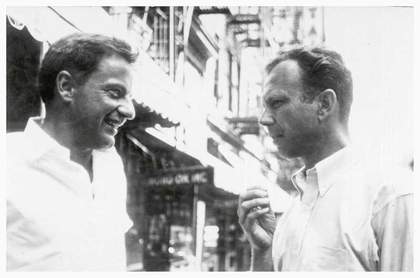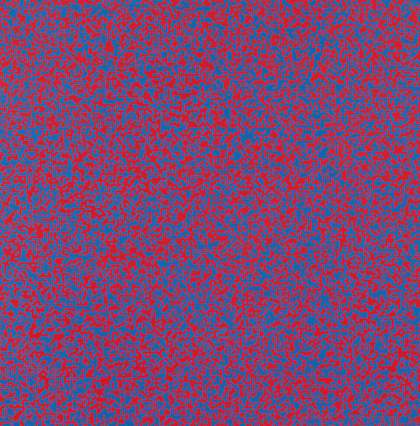
François Morellet and Ellsworth Kelly in New York (1968), photographed by Danielle Morellet
Courtesy Ellsworth Kelly
The catalyst for the idea of the painting Random Distribution of 40,000 Squares using the odd and Even Numbers of a Telephone Directory 1960 came about after a conversation with Ellsworth Kelly, who at the time was living in France. He had recently visited Jean Arp’s studio and talked about one of Arp and Sophie Taeuber’s joint collages, Squares Arranged to the Laws of Chance, made in 1917. From an early stage in my career I looked for ways to take the fewest possible subjective decisions in the process of the creation of a painting. I wanted to be radically different from the lyrical abstraction of the École de Paris, which was the mainstream trend at that time, represented by popular artists such as Mathieu.
An earlier influence on how I thought about my painting came from a stay in Brazil, where my wife and I planned to emigrate to escape a possible third world war that threatened to spread from Korea during the early 1950s. In 1950 Max Bill had a big exhibition at the Museu de Arte Moderna in São Paulo, which had a tremendous impact. His work and approach (what he called ‘Concrete art’) was a major influence in South America from that time and until now. I went over to Brazil shortly after this show, which I discovered only through photographs and enthusiastic comments from young Brazilian artists.
However, the legacy starting with Mondrian, followed by the Concrete movement with Theo van Doesburg, then with Bill, was preceded by my very first enthusiasm for Oceanian ‘Tapas’ with their repetition of printed shapes, which I discovered at the ethnological Musée de l’Homme of Paris in the 1940s. My third major shock came from the abstract Islamic networks of lines and repetitive pattern all over the walls of the Alhambra Palace in Granada on my first visit in 1952.

François Morellet
Random Distribution of 40,000 Squares using the Odd and Even Numbers of a Telephone Directory
Installation view at Kunsthaus, Zürich 2006
Wallpaper, carpet, lightbulb
460 x 430 cm
Courtesy Kunsthaus Zürich © François Morellet
With Random Distribution, the purpose of my system was to cause a reaction between two colours of equal intensity. I drew horizontal and vertical lines to make 40,000 squares. Then my wife or my sons would read out the numbers from the phone book (except the first repetitive digits), and I would mark each square for an even number while leaving the odd ones blank. The crossed squares were painted blue and the blank ones red. For the 1963 Paris Biennale I made a 3-D version of it that was shown among the Groupe de Recherche d’Art Visuel installations (and re-created it again on different occasions). I wanted to create a dazzling fight between two colours that shared the same luminosity. This balance of colour intensity was hard to adjust because daylight enhances the blue and artificial light boosts the red. I wanted the visitors to have a disturbing experience when they walked into this room – to almost hurt their eyes with the pulsating, flickering balance of two colours. I like that kind of aggression.

